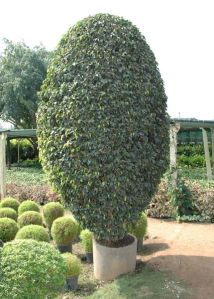
Ficus Plant
299 Per Piece
100 Piece(s) (MOQ)
Description Ficus is a pan-tropical genus of trees, shrubs and vines occupying a wide variety of ecological niches; most are evergreen, but some deciduous species are endemic to areas outside of the tropics and to higher elevations. Fig species are characterized by their unique inflorescence and distinctive pollination syndrome, which utilizes wasp species belonging to the family Agaonidae for pollination. The specific identification of many of the species can be difficult, but figs as a group are relatively easy to recognize. Many have aerial roots and a distinctive shape or habit, and their fruits distinguish them from other plants. The fig fruit is an enclosed inflorescence, sometimes referred to as a syconium, an urn-like structure lined on the inside with the fig’s tiny flowers. The unique fig pollination system, involving tiny, highly specific wasps, known as fig wasps that enter via ostiole these sub-closed inflorescences to both pollinate and lay their own eggs, has been a constant source of inspiration and wonder to biologists. Finally, there are three vegetative traits that together are unique to figs. All figs possess a white to yellowish latex, some in copious quantities; the twig has paired stipules or a circular stipule scar if the stipules have fallen off; and the lateral veins at the base of the leaf are steep, forming a tighter angle with the midrib than the other lateral veins, a feature referred to as “tri-veined”. There are no unambiguous older fossils of Ficus. However, current molecular clock estimates indicate that Ficus is a relatively ancient genus being at least 60 million years old, and possibly as old as 80 million years. The main radiation of extant species, however, may have taken place more recently, between 20 and 40 million years ago. Some better-known species that represent the diversity of the genus include the common fig, a small temperate deciduous tree whose fingered fig leaf is well known in art and iconography; the weeping fig (F. benjamina), a hemi-epiphyte with thin tough leaves on pendulous stalks adapted to its rain forest habitat; the rough-leaved sandpaper figs from Australia; and the creeping fig (F. pumila), a vine whose small, hard leaves form a dense carpet of foliage over rocks or garden walls. Moreover, figs with different plant habits have undergone adaptive radiation in different biogeographic regions, leading to very high levels of alpha diversity. In the tropics, it is quite common to find that Ficus is the most species-rich plant genus in a particular forest. In Asia as many as 70 or more species can co-exist. Ficus species richness declines with an increase in latitude in both hemispheres. Ficus is a pan-tropical genus of trees, shrubs and vines occupying a wide variety of ecological niches; most are evergreen, but some deciduous species are endemic to areas outside of the tropics and to higher elevations. Fig species are characterized by their unique inflorescence and distinctive pollination syndrome, which utilizes wasp species belonging to the family Agaonidae for pollination.